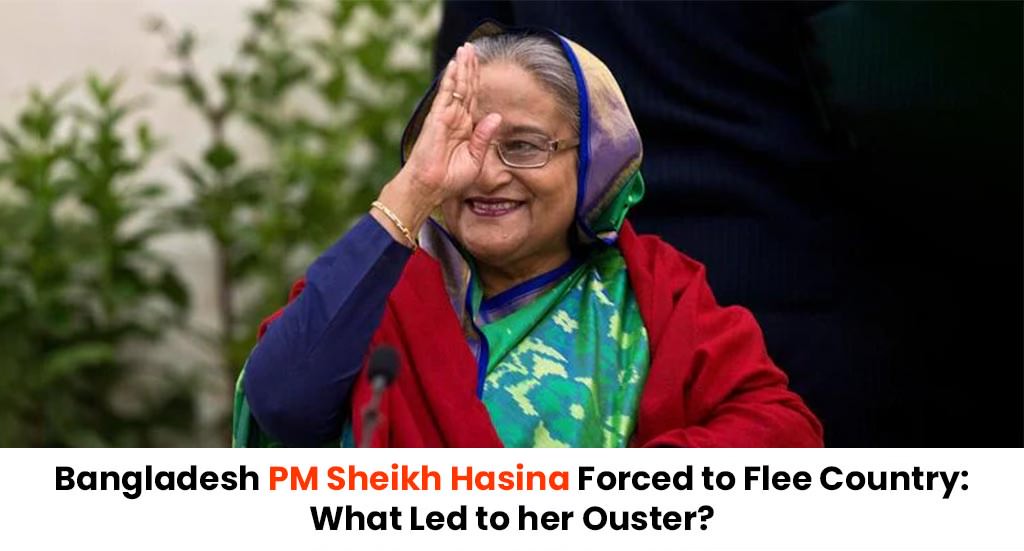Sheikh Hasina, the Prime Minister of Bangladesh, has resigned and left the country amid escalating violence and protests. Over 300 people have died in the unrest, which includes protests and a storming of the presidential palace. The protests, which initially targeted job quota issues, escalated into widespread anger against Hasina. Accusations of suppressing the opposition and dictatorial behaviour fuelled the unrest. The unity of the opposition played a significant role in her resignation. The situation has led to an internet shutdown. Sheikh Hasina arrived in Delhi from Dhaka on Monday, where she will stay for ‘some more time,’ according to her son Sajeeb Wazed Joy. She will then reportedly go to London. An interim government is now taking over, as announced by Army Chief General Waqar-uz-Zaman.
Hasina, who had been in power since 2009 and was elected for a record fourth consecutive term in January’s election, faced a boycott from the main opposition party. Sheikh Hasina first became Bangladesh’s Prime Minister in 1996 after her Awami League party won the elections. Her second term, starting in 2009, saw significant economic growth, but her 15-year rule was also marked by accusations of becoming a hardline leader, cracking down on dissent, and committing human rights violations.
The former Bangladesh prime minister is set to leave for London after a brief stay in India, where she landed at Hindon airbase near New Delhi. During her stay, Indian national security advisor Ajit Doval and Foreign Minister S. Jaishankar met with her, and Jaishankar briefed PM Narendra Modi on the situation in Bangladesh. The aircraft carrying Hasina and her sister was tracked by Indian security agencies. There are speculations about a possible conspiracy involving political players to oust Hasina, with Foreign Minister Jaishankar suggesting that foreign powers, including Pakistan, could be involved, as discussed in an all-party meeting.
How it started?
The protests began over anger at a quota system that reserved 30 percent of government jobs for relatives of 1971 War of Independence veterans. Led by student groups such as ‘Students Against Discrimination,’ the demonstrations initially focused on the quota but escalated to demands for Sheikh Hasina’s resignation. Despite the Supreme Court’s decision on July 21 to eliminate most quotas, the unrest continued, with protesters calling for justice for the deceased, restoration of internet access, and the reopening of campuses.
Protests in Bangladesh intensified, with critics accusing Sheikh Hasina’s government of excessive force, which the government denies. Initially, Hasina’s administration blamed Jamaat-e-Islami and the BNP for the unrest, dismissing the role of student groups. Economic issues, including stagnation, high inflation, and youth unemployment, have fuelled the protests. Hasina’s fourth term, secured amid allegations of election fraud and repression, has faced criticism from the BNP, which claims its supporters were persecuted.
How did Sheikh Hasina flee?
As massive protests closed in on her residence, Sheikh Hasina faced a critical decision: use force against her people or flee the country. After hours of deliberation, phone calls, and meetings, Hasina, who had led Bangladesh since 2009, ultimately chose to leave. Despite clinging to power until the last moment, she pressured top officials to act, but by then, the streets of Dhaka were overwhelmed with protestors. The overwhelming crowd led to her eventual escape to India, marking the end of her tenure in Bangladesh.
When Sheikh Hasina’s jet landed at Hindon air base at 5:45 PM, she was met by National Security Advisor Ajit Doval, who held an hour-long meeting with her to discuss the situation in Bangladesh and her future plans. Doval then briefed Prime Minister Narendra Modi and the Cabinet Committee on Security, with the PM being kept informed of developments throughout the day.
Sheikh Hasina may soon leave for Finland or the UK, as New Delhi is unlikely to host her for long, unlike in 1975 when she and her sister were sheltered in India after their father’s assassination. They had previously lived in a safe house in New Delhi for six years under Prime Minister Indira Gandhi’s government. This time, India is cautious about extending such hospitality, as it could escalate anti-India sentiment among radical elements in Bangladesh.
India has been closely monitoring the situation in Bangladesh since protests over the government job quota turned violent. Anti-India elements infiltrated these protests, which also opposed the government’s crackdown. After nearly 100 people were killed in clashes, India advised its citizens to avoid travelling to Bangladesh, and around 4,500 Indians, mostly students, returned last month.
Over the past 16 years, Sheikh Hasina reversed the previous BNP government’s policy of allowing insurgent groups from India’s northeast to operate in Bangladesh. Cooperation between Indian and Bangladeshi security agencies led to the arrest of several insurgent leaders and the launch of connectivity projects benefiting both countries, especially India’s northeastern states.
Sheikh Hasina’s departure marks a significant turning point in Bangladesh-India relations, as both nations navigate the complexities of regional security and political stability. While her tenure saw unprecedented cooperation between the two countries, particularly in counterinsurgency and economic connectivity, the current unrest poses challenges that could reshape the future of this bilateral partnership. As the situation in Bangladesh continues to evolve, India’s response will be crucial in maintaining regional stability and protecting its interests in the neighbourhood.








